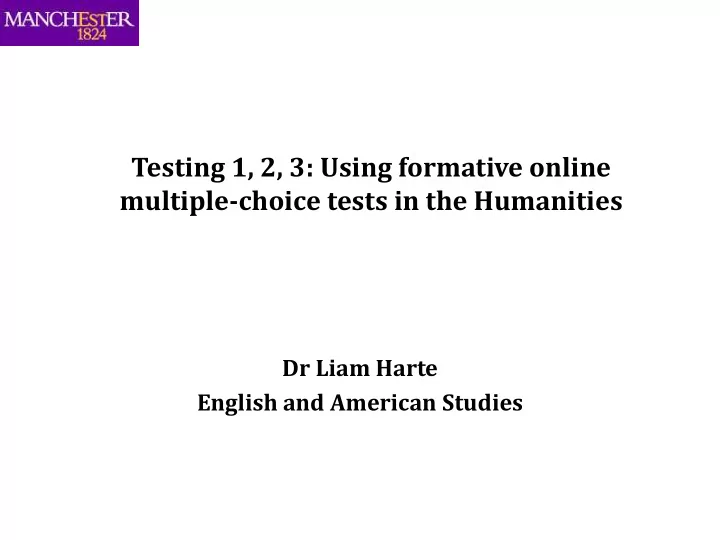

Testing 1, 2, 3: Using formative online multiple-choice tests in the Humanities Dr Liam Harte English and American Studies
Learning Scenario Popular Level 2 course, Writing, Identity and Nation. Summative assessment is by coursework essay and written examination. Some year-on-year student dissatisfaction about lack of early, formative feedback on their levels of knowledge and understanding.
Solution Multiple-choice test delivered via Blackboard 9 in Week 6. Questions drawn from material covered in Weeks 1 – 6. Each answer has a piece of feedback attached which appears when students access their scores. Test features a ‘confidence - based answering’ component .
Sample Question Question: When Benedict Anderson argues that nations are ‘imagined communities’ does he mean that: A. Nations are intellectual constructions with no basis in reality? B. Nations are brought into being by imaginative writing (fiction, poetry, drama, etc.)? C. Nations have a physical and emotional presence that is defined and potentially redefined by cultural representations? D. Nations have a fixed institutional, physical and political reality that is more or less unchanging?
Feedback: The correct answer is C. Anderson suggests that in order to understand nations we ‘need to consider carefully how they have come into historical being, in what ways their meanings have changed over time, and why, today, they command such profound emotional legitimacy’ ( Imagined Communities , p. 4).
Confidence Index Correct Answer + Confident = 20 points Correct Answer + Semi-Confident = 15 points Correct Answer + Not Confident = 10 points Wrong Answer + Confident = 0 points Wrong Answer + Semi-Confident = 1 point Wrong Answer + Not Confident = 2 points Unanswered questions carry 0 points.
Student Response A good deal of positivity about the intellectual challenge posed by the test but also some negativity about recurring technical problems in accessing the test itself and the test scores. A significant proportion of students (40%) experienced a particular technical problem: they could not access their scores or feedback when taking the test remotely. Those who reported this problem were either helped to resolve it by an eLearning technologist or advised to take the test on a campus computer, where this problem did not appear to show up.
Student Response More than two thirds (69%) of the students who responded found some aspects of the test ‘Helpful’ or ‘Very Helpful’. Of these, 41% experienced some technical problems accessing their scores/ feedback. Out of the 31% who did not find it ‘Helpful’, 38% experienced technical problems accessing their scores/feedback. Although the proportion of students who experienced technical difficulties is a little lower amongst those who found the test ‘Not Very Helpful’ or ‘Unhelpful’, closer analysis of their comments seem to indicate that more of them would have found the test ‘Helpful’ if they could have received their scores/feedback.
Student Response Of those who commented on the ‘confidence - based answering’ feature of the test, 32% found it ‘Helpful’ or ‘Very Helpful’, 14% found it ‘Not Very Helpful’ and 5% found it ‘Unhelpful’.
Reasons why students said they liked the test ‘Provides immediate feedback’. ‘Exposed gaps in my knowledge’. ‘Ensured I did the weekly reading and that I engaged with it fully’. ‘Made me read more attentively and think a bit more about the secondary reading’. ‘Questions were challenging and specific’. ‘Helped me to remember the main ideas of the readings’. ‘I gained an overall perspective on the course and its objectives’. Confident- based answering component ‘encouraged me to be a bit more confident in my answers’ and ‘showed me what parts of the course I needed to revise’.
‘Layout of test was confusing at first’. ‘The questions weren’t challenging enough’. Confident- based answering component feature was ‘confusing’. ‘Not enough “yes” or “no” answers’. ‘The current assessment methods are satisfactory ’.
What Next? Technical problems must be resolved before test is re-run. Modify confidence-based answering component to make it more user-friendly. Expand the question base or expand the test to encompass material covered in second half of course?
Recommend
More recommend